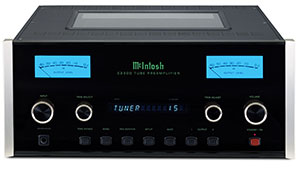 Sherlock Holmes, in an episode of the CBS show Elementary this past week (Feb 14th) showed a close-up of a cool audio device called the McIntosh C2300 Preamplifier. Holmes was using it to play loud music in his house so the neighbors would not hear him firing a gun to conduct a ballistics test. The camera zoomed in very close to the face of the McIntosh and stayed there for a few seconds. It seemed pretty obvious that it was a paid product placement. But I’d never heard of it before. So what is it?
Sherlock Holmes, in an episode of the CBS show Elementary this past week (Feb 14th) showed a close-up of a cool audio device called the McIntosh C2300 Preamplifier. Holmes was using it to play loud music in his house so the neighbors would not hear him firing a gun to conduct a ballistics test. The camera zoomed in very close to the face of the McIntosh and stayed there for a few seconds. It seemed pretty obvious that it was a paid product placement. But I’d never heard of it before. So what is it?
McIntosh makes high-quality consumer audio electronics, specifically focusing on the units that serve as the audio hub for your home theater or entertainment center. The C2300 has a bunch of inputs on the back to pug in your TV, CD player, cable box router, Apple TV, etc. and even a record player. It has 2 phono inputs, which are not easy to find anymore, since record players are pretty rare and require special processing. Specifically it has 6 stereo and 2 phono inputs (unbalanced) and 3 balanced stereo inputs. And in addition to the headphone outputs, it has 3 balanced stereo outputs and 3 unbalanced stereo outputs.
Another thing that sets this model apart from some others is that it is a tube preamplifier, which means that it uses vacuum tubes instead of transistors. Tubes are often preferred for audio applications for how they sound, imparting a warm and lovely quality to the audio. But that is arguably what makes it so expensive.
These are expensive high-end pieces of home audio gear that you won’t find on Amazon or anywhere on-line (that I could find). You’ll have to go to your closest high-end home theater and audio dealer. Here in San Antonio you can get them at Bjorns. The C2300 goes for about $4,500. I know, right!? But Sherlock Holmes has access to – as he puts it – certain funds. So I guess he can afford it.
Check out the McIntosh website for more information on the C2300 Tube Preamplifier.
preamp
Microphone, Preamp And Converter If Money Were Not A Factor?
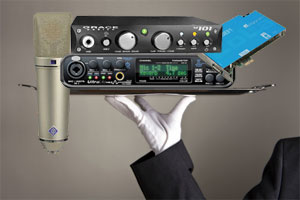 One of my readers sent me an e-mail that asked the following:
One of my readers sent me an e-mail that asked the following:
Ken,
Out of sheer curiosity, if you were shopping for a voiceover microphone and preamp and money weren’t a factor, what would you pick?
Same question with a 2,000 budget.
Thank you, and have a fantastic night!
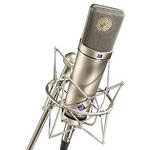

It was really a fun exercise, kinda like when someone asks you what you would do if you won the lottery. I looked into a lot of high-end audio gear for this. Since this particular person was interested in a voice-over set-up, it helped me focus my research. I wouldn’t need the capability to record multiple microphone inputs at once like I would for music recording, where I’d want enough microphone inputs and simultaneous recording capability to handle at least 8, but more likely 16 sources. Also, my choices would have to work with Windows, since I don’t own a Mac. Anyway, below is the result of my trip to fantasy land of unlimited budgets:
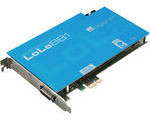
Sorry for the delay. If money were no factor I would probably not have a single “interface” unit, but a 3-part preamp, A/D converter, and I/O interface. I think an excellent set-up would be a Neumann U87 mic (~$3,600) going through a Grace Design m101 Preamp (~$700) going through a Forssell MADC-2 ($2,950) going into a Digigram LoLa881 PCIe Multi-Channel Digital Audio Card ($969). So I guess that would come to about $8,219. Fun exercise;).


For a budget of $2,000 I’d do a Sennheiser MKH 416 shotgun mic (~$1,000) into an MOTU UltraLIte-mk3 Hybrid FireWire/USB Audio & MIDI Interface (~$539) for a total of $1,539. I couldn’t find any other combo that fit under $2,000. The next closest exceeds it by $549, and that combo would be the MKH 416 into an RME Fireface UCX – USB and FireWire Audio Interface ($1,549).
This was a really fun exercise. Now I know better what kinds of high-end audio gear is available if I’m ever so rich that money becomes “no object.” For those of your who are already there, well here is a good list to get you going;).
Matching A Microphone To A Preamp
 In 2012 the likelihood that a decent recording microphone will be horribly mismatched with a decent mic preamp (included in the audio interface units I talk about on this site) is, in my opinion, really low. Now, when I say “decent,” I’m talking about microphones from well-known and respected manufacturers like Shure, Audio-Technica, Rode, Neumann, AKG, Blue, Mojave Audio, etc. Preamps (see our article – What is a Mic Preamp?) these days are almost always integrated with the audio interface, and in the case of a USB mic, integrated directly into the mic (so need for worrying about mismatches). When I say “decent” in the context of audio interfaces, again you’re unlikely to go wrong with units by companies like M-Audio/Avid, EMU, CEntrance, ART, PreSonus, Focusrite, Behringer, etc. Obviously there are more, especially in the very high-end market. But my point is this – if you have an Audio-Technica AT2035 microphone (see our review here: Review of the Audio-Technica AT2035 Microphone), you don’t need to worry whether plugging it into an M-Audio Fast Track C-600 interface. It’ll sound great!
In 2012 the likelihood that a decent recording microphone will be horribly mismatched with a decent mic preamp (included in the audio interface units I talk about on this site) is, in my opinion, really low. Now, when I say “decent,” I’m talking about microphones from well-known and respected manufacturers like Shure, Audio-Technica, Rode, Neumann, AKG, Blue, Mojave Audio, etc. Preamps (see our article – What is a Mic Preamp?) these days are almost always integrated with the audio interface, and in the case of a USB mic, integrated directly into the mic (so need for worrying about mismatches). When I say “decent” in the context of audio interfaces, again you’re unlikely to go wrong with units by companies like M-Audio/Avid, EMU, CEntrance, ART, PreSonus, Focusrite, Behringer, etc. Obviously there are more, especially in the very high-end market. But my point is this – if you have an Audio-Technica AT2035 microphone (see our review here: Review of the Audio-Technica AT2035 Microphone), you don’t need to worry whether plugging it into an M-Audio Fast Track C-600 interface. It’ll sound great!
However, I’m a fan of the old saw – knowledge is never wasted. And there are still times, especially when working with very high-end equipment looking for the pinnacle of conceivable performance specs, when it could be handy to understand how the electronics interact with one another to degrade or enhance the resulting sound. In that vein, I refer you to this article explaining the terms and numbers involved in mic and preamp specs:
http://www.prosoundweb.com/article/selecting_the_right_preamp_for_your_microphone/
What is a Mic Preamp?
 The term preamp, most often paired with the word microphone is something you’ll see a lot if you do much reading about audio recording. So what is a preamp? Well first off, it’s short for “preamplifier.” Second, yes – it is a thing that amplifies something before it goes to an amplifier. I know, I know – more confusing terminology in the audio recording world. Shocker. That’s one of the reasons I write these articles.
The term preamp, most often paired with the word microphone is something you’ll see a lot if you do much reading about audio recording. So what is a preamp? Well first off, it’s short for “preamplifier.” Second, yes – it is a thing that amplifies something before it goes to an amplifier. I know, I know – more confusing terminology in the audio recording world. Shocker. That’s one of the reasons I write these articles.
OK, so what are they talking about when they say “microphone preamplifier” or “mic pre” for short? Here it is. Microphones put out really quiet levels. But audio recorders (and other devices that ultimately amplify and send signals to speakers) need something a called a line level, which is quite a bit louder than mic level. So you need a device to boost (amplify) a microphone level to line level. And that device is called…you guessed it…a preamplifier.
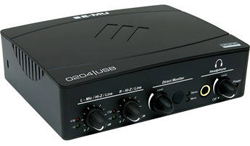
Anything you can plug a microphone into (well, that EXPECTS to have a mic plugged into it – I guess technically you could plug one into your ear) will have a mic preamp built in. A computer sound card, for example, has a little hole with the word mic written write next to it. There will be a preamp in there somewhere. Likewise, most mixers have microphone inputs which have preamps in them. But neither of the above examples of preamps are ideal for recording.
To keep cost down, mixer manufacturers use inexpensive preamps since there are a bunch of them on board. Built-in sound cards on computers are also very cheap since most folks aren’t using them to record pro quality audio.
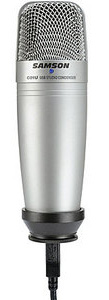
So if we are going to record great sounding audio with our computers, we need good mic preamps. Most audio interface units these days (meaning circa 2012) only have 1 or 2 mic preamps built in (such as with the E-MU 0204 interface), and that is what you are mainly paying for. They are much quieter and cleaner than the ones in mixers or computers, which is why they sound so much better. Oh, and something else handy to know is that USB mics (like the Samson C01U) have preamps built right into them.
So that’s my answer to the question “what is a mic preamp?” You didn’t want to know much more than that did you? Well, if you do, you can do the bonus reading below. I asked someone to give me 400 words on what a preamp was and I got what I asked for; a technical and academic sounding description. But hey, some folks may be interested so to you I say “read on!”
Cheers!
Ken
Extra credit reading on preamps
A broadly used term in the world of audio is the word “preamp”. Defined, a preamp is an amplifier that prepares electrical signals for increased amplification prior to them being received by the main amplifier. By design a preamp is supposed to do one or a combination of the following functions: increase the gain or the amount the signal level, convert unbalanced levels to balanced, change the tone, and/or lower output impedance.
Essentially the preamp works to make sure that there is an effective relationship between input and output so that the power it takes to receive and produce a sound isn’t compromised. Without going too deep into the technical explanations of each of the before mentioned uses of a preamp, one could say that the preamp is a multifaceted audio device.
When speaking of preamps it’s often discussed in relation to a separate power amp. The preamp is the signal processing component of an amplifier. Traditionally, the way you got better sound quality was to separate the two sections of the amplifier. Separating the preamp from the power amp redesigns your power supply so it is capable of managing electronics of more complex or sensitive signals without the interference from a nosier amplifier. In most cases when discussing preamps, users tend to mean amplifiers that are separate from the power amp. This would require a detached power amp to power speakers. An amplifier with both sections in it is called an integrated amplifier or just a plain old amp.
The versatility of a preamp as an audio tool shapes the sounds of an amplified microphone or instrument. The preamp usually includes dials that act as tone controls that adjust low, mid and high frequencies. The dials allow users to increase or decrease bass and treble as they see fit. Once the signal is processed the user now has the tone and sound they desired.
Preamplifiers may be found incorporated into home audio systems where the term takes on additional definitions. Most often, home audio preamps simply mean the device that switches between altered line level sources. In this sense no true amplification takes place; however the preamp does supply voltage to the amp. This is enough voltage to power loud speakers although it doesn’t register as a significant current gain.
Preamps can also be found implanted in other pieces of equipment like turntables, microphones and electric/bass guitars.